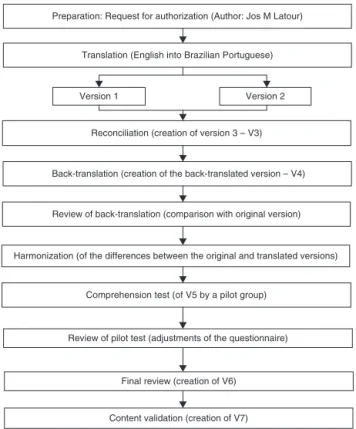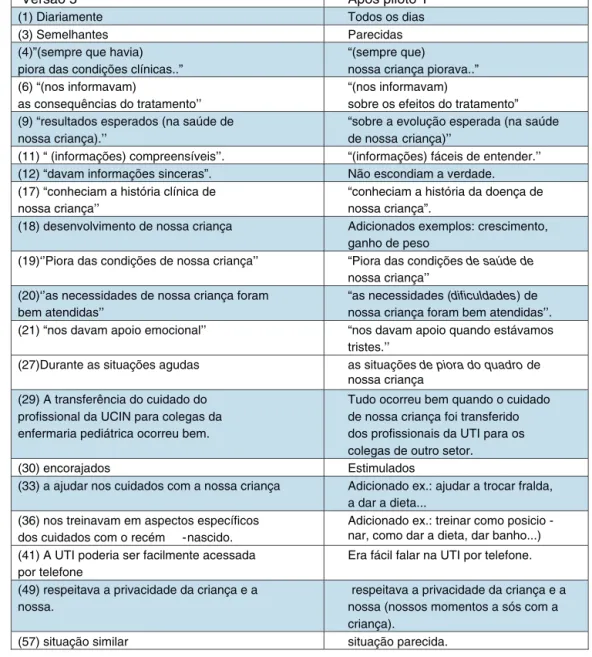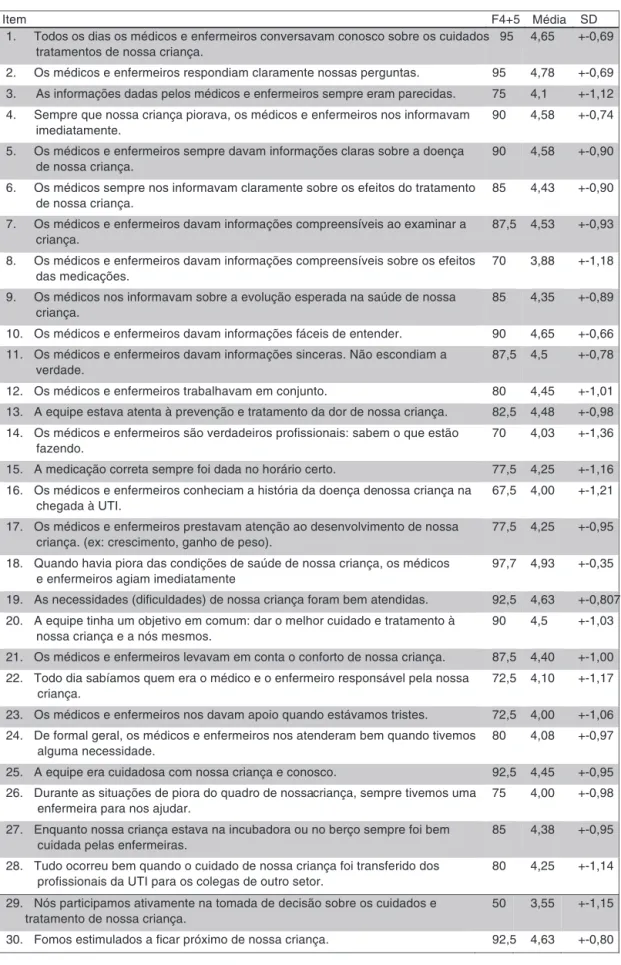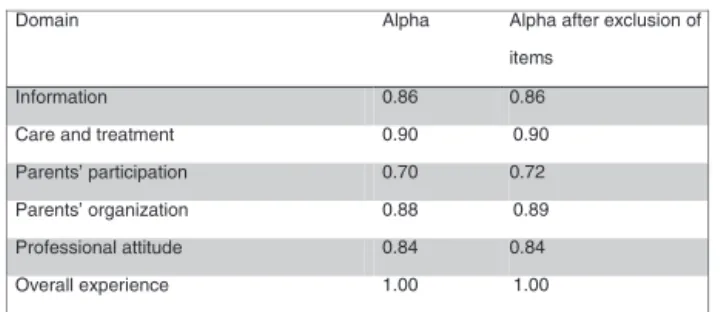www.jped.com.br
ORIGINAL
ARTICLE
Brazilian
adaptation
and
validation
of
the
Empowerment
of
Parents
in
the
Intensive
Care-Neonatology
(EMPATHIC-N)
questionnaire
夽
,
夽夽
Dafne
B.C.A.
Gomez
a,∗,
Suely
A.
Vidal
a,b,
Luciana
C.S.
Lima
caInstitutodeMedicinaIntegralProf.FernandoFigueira(IMIP),Recife,PE,Brazil
bInstitutodeMedicinaIntegralProf.FernandoFigueira(IMIP),GrupodeEstudosemGestãoeAvaliac¸ãoemSaúde(GEAS),Recife,
PE,Brazil
cInstitutodeMedicinaIntegralProf.FernandoFigueira(IMIP),ProgramadeResidênciaMédica,Recife,PE,Brazil
Received14September2015;accepted14June2016 Availableonline24August2016
KEYWORDS
Neonatalintensive care;
Qualityofhealth care;
Patientsatisfaction; Parents;
Translation(product); Validationstudy
Abstract
Objectives: Considering thelack ofquestionnaires thatpropose toevaluate parental satis-factionwiththeNeonatalIntensiveCareUnit(NICU)inBrazil,thisstudyaimedtocarryout thetranslationoftheEMPATHIC-NquestionnaireintoBrazilianPortuguese,thecross-cultural adaptationandvalidationofitscontents.
Method: Thetranslationandculturaladaptationofthequestionnairewascarriedoutaccording totheprotocolestablishedbytheTranslationandCross-CulturalAdaptationGroupofthe Inter-nationalSocietyforPharmacoeconomicsandOutcomesResearch(ISPOR)in2005.Thevalidation ofthecontentwas carriedoutbyapanelofexperts,whoevaluatedeachitemfrom‘‘very irrelevant’’ to‘‘veryrelevant’’. Itemswith ameanLikert scalevalue <3.5were excluded. Cronbach’salphaofthedomainswascalculated.
Results: Thequestionnairewassubmittedtotwopilottestswithmothersofnewbornsadmitted totheNICUofthestudy,afterwhichsometermsweremodifiedtoachieveglobalunderstanding. Cronbach’salpharemainedabove0.7inallitems.
Conclusion: Thetoolresultingfromthetranslation,culturaladaptation,andvalidationofthe EMPATHIC-Nquestionnaireshowedtobeadequatetoassesssatisfactionofparentsofnewborns admittedtotheNICUinBrazil.
©2016SociedadeBrasileiradePediatria.PublishedbyElsevierEditoraLtda.Thisisanopen accessarticleundertheCCBY-NC-NDlicense(http://creativecommons.org/licenses/by-nc-nd/ 4.0/).
夽
Pleasecitethisarticleas:GomezDB,VidalSA,LimaLC.BrazilianadaptationandvalidationoftheEmpowermentofParentsinthe IntensiveCare-Neonatology(EMPATHIC-N)questionnaire.JPediatr(RioJ).2017;93:156---64.
夽夽
StudycarriedoutatInstitutodeMedicinaIntegralProf.FernandoFigueira(IMIP),Recife,PE,Brazil. ∗Correspondingauthor.
E-mail:dafnebarcala@hotmail.com(D.B.Gomez).
http://dx.doi.org/10.1016/j.jped.2016.06.007
0021-7557/©2016SociedadeBrasileiradePediatria.PublishedbyElsevierEditoraLtda.ThisisanopenaccessarticleundertheCCBY-NC-ND
PALAVRAS-CHAVE
Terapiaintensiva neonatal; Qualidadeda assistênciaàsaúde; Satisfac¸ãodo paciente; Pais;
Traduc¸ão(produto); Estudodevalidac¸ão
Adaptac¸ãobrasileiraevalidac¸ãodoquestionárioEmpowermentofParentsinthe IntensiveCare-Neonatology(EMPATHIC-N)
Resumo
Objetivos: Considerandoaausênciadequestionáriosqueseproponhamaavaliarsatisfac¸ãode paisemUnidadedeCuidadosIntensivos Neonatal(UCIN)noBrasil,opresenteestudoteveo objetivoderealizaratraduc¸ãodoquestionárioEMpowermentofPArentsinTHeIntensive Care-Neonatologyparaoportuguêsbrasileiro,adaptac¸ãotransculturalevalidac¸ãodeseuconteúdo.
Método: Foirealizadatraduc¸ãoeadaptac¸ãotransculturaldoquestionário,segundoprotocolo estabelecido peloGrupo daTraduc¸ãoeAdaptac¸ão TransculturaldaSociedadeInternacional para PesquisasFarmacoeconômicas-ISPORem 2005. Avalidac¸ãodoconteúdo foirealizada atravésdeumcomitêdeespecialistas,avaliandocadaitemde‘‘muitoirrelevante’’a‘‘muito relevante’’.ForamexcluídosositenscommédiadaEscalaLikertmenorque3,5.Foicalculado alfadeCronbachdosdomínios.
Resultados: Natraduc¸ãofoiinvertidaaordemdealgumasfrasesdeacordocomasintaxedo portuguêsbrasileiroealteradootempoverbalparaterceirapessoadopretéritoimperfeito.A maiorpartedasafirmativasmanteveosentidocomaretraduc¸ão,sendoasdiferenc¸asatribuídas autilizac¸ãodesinônimospelosdoistradutores.Foisubmetidoadoistestespilotocommães de recémnascidosinternados naUCIN doestudo,modificando-se algunstermos atéatingir compreensãoglobal.OalfadeCronbachpermaneceuacimade0,7emtodosositens.
Conclusão: O instrumento resultante da traduc¸ão, adaptac¸ão transcultural e validac¸ão do EMPATHIC-Nmostra-seadequadoparaavaliarsatisfac¸ãodospaisderecém-nascidosinternados emUCINnoBrasil.
©2016SociedadeBrasileiradePediatria.PublicadoporElsevierEditoraLtda.Este ´eumartigo OpenAccesssobumalicenc¸aCCBY-NC-ND(http://creativecommons.org/licenses/by-nc-nd/4. 0/).
Introduction
From the perspective of family- and patient-oriented Medicine, the parents’ perception and satisfaction about theirchildren’scareofareconsideredqualitymeasuresfor the evaluation of care.1,2 A literature review found four
toolsintheEnglishlanguagerelatedtoparents’satisfaction with the neonatalintensive care unit (NICU): the Neona-tal IndexofParentSatisfaction(NIPS) scale,the Neonatal Intensive Care Unit---Parent Satisfaction Form (NICU---PSF) questionnaire, the Parental Stress Scale: Neonatal Inten-sive Care Unit (PSS:NICU) scale, and the EMpowerment ofPArentinTHeIntensiveCare-Neonatology(EMPATHIC-N) questionnaire.3
The NIPSis a27-itemquestionnaire,dividedintothree areas: quality of care, communication, and attitudes in care/personality.However,thisscalemostoftenfocuseson the frequency of events in theNICU ratherthan the par-ents’opinionregardingcare.4TheNICU---PSFaddressesthe
conceptsofoverallsatisfaction,continuouscommunication, information,preparation,participationincare,supportfor decision-making,spiritualneedsandclosenessincare,and monitoring.Itsvaliditywasestablishedbycontentvalidity andinternal consistencyanalysis in fiveof itsnine evalu-ated scales, but thereare questions about the qualityof the sample usedfor validation.3 The PSS:NICO is a
ques-tionnaireadaptedfromexperienceinpediatricunits,whose purposeistoevaluatethestressfulexperiencesinthe par-ents, rather than their satisfaction with their children’s care.5
The Dutch questionnaire EMPATHIC-N was developed from an initial list of 92 parental satisfaction indicators with neonatal intensive care, generated from a litera-turereview and expert opinion obtained usingthe Delphi method in two stages. These items were evaluated by parents and caregivers, selecting 67 items, divided into five domains: information, care & treatment, organiza-tion,parentalparticipation,andprofessionalattitude.Each item is answered using a scale from one (1), ‘‘certainly not’’tosix(6),‘‘certainly yes’’,in additiontothe alter-native ‘‘does not apply’’. Four open questions were also added for overall satisfaction assessment, a section for demographicinformation anda free space for parents to expresstheirexperiences.6 Amongthesatisfaction
indica-torsregardingtheprovidedcare,communicationbetween the NICU professionals and parents is highly valued, as it is one of the pillars of family- and patient-oriented medicine, supporting the sharing of information honestly andcompletely, tostimulate the participation of parents indecision-making.7
TheevaluationoftheEMPATHIC-Npsychometrictestswas carriedoutintwocohortsofparentsofpatientsinaDutch NICU;duringthisprocess,10itemswereexcluded, result-ing in 57 items. The internal consistency was evaluated, whichshowedanadequatelevelofreliabilityinalldomains, with Cronbach’s ˛ test >0.8. Spearman’s correlation test
Despitetheimportanceofassessingparentalsatisfaction withneonatalcareinanypopulation,therearenovalidated instrumentspublishedinPortuguesewiththispurpose.This studytranslatedtheEMPATHIC-Nquestionnairecontentinto BrazilianPortuguese,andperformeditscross-cultural adap-tationandvalidation.
Method
Themethodologicalworkoftranslation,cross-cultural adap-tation,andvalidationofEMPATHIC-Ncontentwascarriedout fromMarch2013toDecember2014,intheNICUofInstituto deMedicinaIntegralProf.FernandoFigueira(IMIP).IMIPisa tertiaryhospitalinthecityofRecife,stateofPernambuco, Brazil,whichhasamulti-professionalteam,providing assis-tance exclusively to users of the Brazilian Public Health System(SUS). InIMIP,in2014,therewere5846livebirths and29.3%ofthemwerepretermnewborns.8TheNICUhas
50beds,withameandailyoccupancyof86.9%,mean num-berofadmissionsof139patients/month,andmeanlength ofstayof9.3days.
Thetranslationandculturaladaptationwascarriedout accordingto themethod proposedby the Translationand Cross-CulturalAdaptationGroup ofthe International Soci-etyforPharmacoeconomicsandOutcomesResearch(ISPOR) in 2005.9 This method was suggested by the author of
theEMPATHIC-Nquestionnaire,afterauthorizingthe trans-lation and cultural adaptation. The ISPOR proposes the following steps: Preparation, Translation, Reconciliation, Back-translation, Review of Back-translation, Harmoniza-tion, Comprehension Test, Review after Comprehension Test,andFinalReview(Fig.1).
Preparation: Request for authorization (Author: Jos M Latour)
Version 1 Version 2
Reconciliation (creation of version 3 – V3)
Back-translation (creation of the back-translated version – V4)
Review of back-translation (comparison with original version)
Content validation (creation of V7) Review of pilot test (adjustments of the questionnaire)
Final review (creation of V6) Comprehension test (of V5 by a pilot group)
Harmonization (of the differences between the original and translated versions) Translation (English into Brazilian Portuguese)
Figure 1 Translation, cross-cultural adaptation, and vali-dationofcontent.
Thetranslationconsistsofthecreationoftwotranslated versions, oneby a Brazilian individual withknowledge of theEnglishlanguage(V1)andtheotherbyaBritish individ-ual(V2).V1andV2wereanalyzedbythetranslators,anda singleversioninPortuguese(V3)wascreatedinthe Reconcil-iationstage.IntheBack-translationstep,V3wastranslated backintoEnglish(V4)bytwotranslators,oneBrazilianand onewhosenativelanguagewasEnglish.TheReviewof Back-translationstepwascarriedoutbycomparingtheV4with the EMPATHIC-N questionnaire. The differences were dis-cussed in the Harmonization step, which resulted in the PortugueseversionV5.
IntheComprehensionTeststep,V5wasappliedto par-ents whose children had stayed for more than 48h in the NICU. The questionnaire was answered during hospi-talization in the NICU and the parents were selected by consecutive sampling. Parents were excluded when they declaredtobeilliterateorhadchildrenwhohaddied.The parents signed the Free and Informed Consent (FIC)form and were asked to read, answer, and interpret the ques-tions. The analysis of all answers was carried out by the same researcher. An item wasconsidered not understood whenmorethan15%ofparentsreportednotunderstanding thequestionormistakenlyinterpreteditsmeaning.
Theitemsthatwerenotunderstoodwereadjustedatthe Reviewstep,aftertheComprehensionTest,andthe adjust-ments resulted in the final Portuguese version V6. In the Final Review, adjustments related to typos, grammatical, andlayouterrorsofthequestionnairewerecarriedout.
The Content Validation of the final version was per-formed by expert consensus. The sample consisted of all college/university level employees of the NICU-IMIP who were working during the study period. Employees were excluded if they were onvacation or leave, or attending aresidencyprogram.Themembersofthemultidisciplinary team of NICU-IMIPwere considered experts, consisting of 41neonatologistphysicians,ninenurses,twopsychologists, onespeechtherapist,and12physicaltherapists,totaling65 professionals.Thisnumberofprofessionalsishigherthanthe numberreportedinotherstudies(tento20professionals) toconstitutethepanelofexperts.10
Afterreadingandsigningtheinformedconsentform,the expertsansweredaquestionnaireevaluatingtherelevance ofeachofthe57itemsofthefinalversion(V6)includedina parentalsatisfactionassessmentquestionnaireintheNICU. ALikertscalewithfivepointswasusedfortheanswers,with 5being‘‘veryrelevant’’and1‘‘veryirrelevant’’.Spacewas alsoprovidedforqualitativeobservations.
The data in this step were entered in duplicate using Excel7software(Microsoft,WA,USA)andvalidatedin Epi-Info3.5.3(CentersforDiseaseControlandPrevention,USA). STATAsoftware(StataCorp.2011.StataStatisticalSoftware: Release12.CollegeStation,TX,USA)wasusedfordata anal-ysis,providingfrequencydistribution,mean,andstandard deviationperitem,whereastheinternalconsistency anal-ysis of the items was analyzed by calculating Cronbach’s alpha coefficient for each domain. The items with mean responses higherthan or equalto3.5 weremaintained in the final version of the parental satisfaction assessment tool.11
approvedbytheResearchEthicsCommitteeoftheIMIP,CAE: 18419913.8.0000.5201.
Results
ThetranslationofEMPATHIC-Nwascarriedoutasproposed. DuringthepreparationofV3,theorderofafewsentences wasinvertedaccordingtothesyntaxofBrazilianPortuguese andtheverbtensewaschangedtothethirdpersonsingular, usingthe past continuoustense equivalentinPortuguese, whichismorecommonininformalspeech.Themost com-montermwaschosenforthosethathadsynonyms.
During the Review of the Back-translation of V4, the EMPATHIC-N was jointly compared by the researchers and translators regarding the semantic equivalence. Most statements retained the correctmeaning after the back-translation,withdifferencesbeingattributedtotheuseof synonymsbythetwotranslators.
The statement ‘‘We received sympathy from the doctors and nurses’’ was modified after comparison with the back-translation. Considering that ‘‘Sympathy’’ could be translated as ‘‘compassion’’, ‘‘solidarity’’, or ‘‘understanding’’, it wasconsidered more appropriate to translatethephraseto‘‘Thedoctorsandnursesshowed sol-idarity’’.Atthefinalevaluation,‘‘Howwouldyourateour performance in general?’’ was translatedto ‘‘How would youratetheoverallperformanceofourunit?’’tomakeit cleartotherespondentthatthequestionwasrelatedtothe workoftheprofessionalsintheNICU.
The layout,order,anddivisionof itemsbytopicof the EMPATHIC-NweremaintainedinthePortugueseversionV5, whichwassubmittedtotwocomprehensiontests.The inter-viewees were mothers with a mean age of 28 years, all ofmixed-raceethnicityandwithmorethaneightyearsof schooling,butnonehadacollege/universitydegree.After interviewing eight mothers, their interest was observed regardingtheassessmentoftheservice,withverbalization of their complaints and compliments. Most had difficulty differentiatingnursesfromnursetechnicians,whichcould modifytheassessment.
Therewasapredominanceofextremeresponses(1or6), whichwasattributedtothemothers’difficultyinusingthe Likertscale.Thus,itwasdecidedtoaddcharacterstothe scale,withfacesexpressingsatisfactionordissatisfaction, whichwasreportedtoandaccepted bytheauthorof the originalquestionnaire.
It was observed that questions 41 and 55 were not answered coherently. Question 41 addressed the fact of receivinganexplanatoryleaflet,buttheassessedNICUdoes nothavethismaterial,makingitimpossibletoreviewthis item.Asfor question55,itaddressed the‘‘cultural back-ground’’,whichwasnotunderstoodbytheinterviewees,as itisnotcompatiblewiththiscontext.
Thedifficultyinunderstandingsomeitemsledtothe sub-stitutionofwords orexpressionsbyequivalents thatwere easier tounderstand, or to changes in the order of sen-tences. Exampleswereadded tosome items(Fig.2).The termNICUwasreplacedbyintensivecareunit(ICU),asthis isthetermmostoftenusedinBrazil.
Afterthechangeswerecarriedoutinthequestionnaire, thisversionwassubmittedtoasecondComprehensionTest
withfive mothers. At this step,before the questionnaire washandedtothem,thedifferenceregardingthefunction betweentheprofessionalswasclarifiedandtheexplanation oftheLikert scale wasreinforced.Thistest showed com-pleteunderstandingofitemsandmorevariedresponsesin theLikertscale.
At the Content Validation step, of the 65 profession-als, tenwere excluded because theywere residents,and 55 questionnaires were handed out, of which 40 (72.7%) werereturned,consistingof20neonatologistphysicians,11 nurses,onepsychologist,one speechtherapist, andseven physicaltherapists.Inthegroupofexperts,95%hada post-graduatedegree in theareaand a meanof 10.6 yearsof experienceinneonatology.Onlyoneprofessionalfilledout thespaceintendedforqualitativeobservations.
Themeanandstandarddeviationofresponseswere cal-culated,asshowninFig.3.Items32‘‘Evenduringinvasive procedures,wecouldalways stay closetoourchild’’and 40 ‘‘It was easy to talk to the ICU by telephone’’ were excluded, as they obtained a mean lower than 3.5. The reliabilityof the data collection instrument wasassessed usingtheinternalconsistencyofitemsbycalculating Cron-bach’salphacoefficient.Alldomainsobtainedvalues>0.7 (Fig.4).Afterexcludingitems32and40,Cronbach’salpha wasrecalculated,remaining>0.7inallofthem.
Afterthesesteps,theadapted,translated,andvalidated parentsatisfactionassessment toolfor the NICU in Brazil wasobtained, consistingof 53 itemsplus fouropen ques-tions,keepingthelayoutand thedivisionbysub-items of theoriginalquestionnaire,butwithcharactersrepresenting theLikertscale.
However,atthereviewstep,itwasdecidedto reintro-ducetheitemsthathadbeen excludedduringtheprocess ofculturaladaptation,withatotalof57itemsinthefinal questionnaire, in addition to the four open questions for overallassessmentofsatisfaction,asectionfordemographic information,andaspaceforparentstofreelyexpresstheir experiences.
Discussion
The study carried out the translation into Brazilian Por-tuguese, cross-cultural adaptation, and validation of the contentoftheEMPATHIC-Nquestionnaire.
The Comprehension Test was performed with mothers to make it accessible to the assessed population, as the EMPATHIC-Nisself-appliedandwasdevelopedinthe Nether-lands, which has a different socioeconomic and cultural profile,withlowsocialinequalityandeasyaccesstohealth services.13
WhenassessingtheprofileofpregnantBrazilianwomen, as shown in the ‘‘Nascer no Brasil’’ study carried out from 2011 to 2012, it identified women with a mean age of 25.7 years, of whom 18.2% were adolescents and 10.5% were 35 years or older. Of the respondents, 73.5% had at least eight years of schooling and only 8.9% of them had a college/university degree.14 The 2014 IMIP
Versão 5 Após piloto 1
(1) Diariamente Todos os dias
(3) Semelhantes Parecidas
(4)”(sempre que havia) piora das condições clínicas..”
“(sempre que)
nossa criança piorava..” (6) “(nos informavam)
as consequências do tratamento’’
“(nos informavam)
sobre os efeitos do tratamento” (9) “resultados esperados (na saúde de
nossa criança).’’
“sobre a evolução esperada (na saúde de nossa criança)’’
(11) “ (informações) compreensíveis’’. “(informações) fáceis de entender.’’ (12) “davam informações sinceras”. Não escondiam a verdade. (17) “conheciam a história clínica de
nossa criança’’
“conheciam a história da doença de nossa criança”.
(18) desenvolvimento de nossa criança Adicionados exemplos: crescimento, ganho de peso
(19)‘’Piora das condições de nossa criança’’ “Piora das condições de saúde de nossa criança’’
(20)‘’as necessidades de nossa criança foram bem atendidas’’
“as necessidades (dificuldades) de nossa criança foram bem atendidas’’. (21) “nos davam apoio emocional’’ “nos davam apoio quando estávamos
tristes.’’
(27)Durante as situações agudas as situações de piora do quadro de nossa criança
(29) A transferência do cuidado do profissional da UCIN para colegas da enfermaria pediátrica ocorreu bem.
Tudo ocorreu bem quando o cuidado de nossa criança foi transferido dos profissionais da UTI para os colegas de outro setor.
(30) encorajados Estimulados
(33) a ajudar nos cuidados com a nossa criança Adicionado ex.: ajudar a trocar fralda, a dar a dieta...
(36) nos treinavam em aspectos específicos dos cuidados com o recém -nascido.
Adicionado ex.: treinar como posicio -nar, como dar a dieta, dar banho...) (41) A UTI poderia ser facilmente acessada
por telefone
Era fácil falar na UTI por telefone.
(49) respeitava a privacidade da criança e a nossa.
respeitava a privacidade da criança e a nossa (nossos momentos a sós com a criança).
(57) situação similar situação parecida.
Figure2 Demonstrationofthemodifiedtermsafterthefirstpilottestbyeachitemofversion5.
In theNetherlands, thepresence of immigrant popula-tions,with culturaldiversity andlanguage barriersin the NICU environment, can lead to increasedmaternal stress if the situations are not well managed.15 In spite of the
provenimportanceofthisissue,thepilottestdemonstrated thatthequestion‘‘Ourculturalbackgroundwastakeninto account’’wasnotunderstoodbytheinterviewees,andthus wasexcluded.Thiswaslikelyduetothefactthatthereare nomajorinternal culturaldifferences inthe Northeastof Brazil,butitmaypossiblyoccurinotherBrazilianregions, suchastheNorth,wherethereareindigenouspopulations ofdifferentethnicgroups,orintheSoutheast,wherethere aremoreimmigrants.
Thereliabilityofthedatacollectiontoolusedforcontent validationby theexpertpanel wasmeasured byanalyzing theinternalconsistencyofitemsthroughCronbach’salpha coefficient.Values>0.7foralldomainsdemonstrateits reli-abilityinassessingtherelevanceoftheitemsmaintainedin
thetoolfinalversion.13Thestatisticalanalysisofthisphase
resultedintheexclusionoftwoitems.13
Oneof theitemsaddresses thepermanenceof parents duringinvasive procedures.Althoughthepresence of par-ents is supported by the literature, the experts did not consider the presence of this item to be relevant in the assessment of parental satisfaction, which may reflect a habitualcustomofsomeneonatalunits.16,17 TheAmerican
HeartAssociation,however,recommendsthatitshouldbe afamilydecisionregardingwhetherornottobepresentat thetimeofcardiacresuscitation.18
1. Todos os dias os médicos e enfermeiros conversavam conosco sobre os cuidados 95 tratamentos de nossa criança.
4,65 +-0,69
2. Os médicos e enfermeiros respondiam claramente nossas perguntas. 95 4,78 +-0,69 3. As informações dadas pelos médicos e enfermeiros sempre eram parecidas. 75 4,1 +-1,12
4. Sempre que nossa criança piorava, os médicos e enfermeiros nos informavam imediatamente.
90 4,58 +-0,74
5. Os médicos e enfermeiros sempre davam informações claras sobre a doença de nossa criança.
90 4,58 +-0,90
6. Os médicos sempre nos informavam claramente sobre os efeitos do tratamento de nossa criança.
85 4,43 +-0,90
7. Os médicos e enfermeiros davam informações compreensíveis ao examinar a criança.
87,5 4,53 +-0,93
8. Os médicos e enfermeiros davam informações compreensíveis sobre os efeitos das medicações.
70 3,88 +-1,18
9. Os médicos nos informavam sobre a evolução esperada na saúde de nossa criança.
85 4,35 +-0,89
10. Os médicos e enfermeiros davam informações fáceis de entender. 90 4,65 +-0,66 11. Os médicos e enfermeiros davam informações sinceras. Não escondiam a
verdade.
87,5 4,5 +-0,78
12. Os médicos e enfermeiros trabalhavam em conjunto. 80 4,45 +-1,01 13. A equipe estava atenta à prevenção e tratamento da dor de nossa criança. 82,5 4,48 +-0,98 14. Os médicos e enfermeiros são verdadeiros profissionais: sabem o que estão
fazendo.
70 4,03 +-1,36
15. A medicação correta sempre foi dada no horário certo. 77,5 4,25 +-1,16 16. Os médicos e enfermeiros conheciam a história da doença denossa criança na
chegada à UTI.
67,5 4,00 +-1,21
17. Os médicos e enfermeiros prestavam atenção ao desenvolvimento de nossa criança. (ex: crescimento, ganho de peso).
77,5 4,25 +-0,95
18. Quando havia piora das condições de saúde de nossa criança, os médicos e enfermeiros agiam imediatamente
97,7 4,93 +-0,35
19. As necessidades (dificuldades) de nossa criança foram bem atendidas. 92,5 4,63 +-0,807 20. A equipe tinha um objetivo em comum: dar o melhor cuidado e tratamento à
nossa criança e a nós mesmos.
90 4,5 +-1,03
21. Os médicos e enfermeiros levavam em conta o conforto de nossa criança. 87,5 4,40 +-1,00
22. Todo dia sabíamos quem era o médico e o enfermeiro responsável pela nossa criança.
72,5 4,10 +-1,17
23. Os médicos e enfermeiros nos davam apoio quando estávamos tristes. 72,5 4,00 +-1,06 24. De formal geral, os médicos e enfermeiros nos atenderam bem quando tivemos
alguma necessidade.
80 4,08 +-0,97
25. A equipe era cuidadosa com nossa criança e conosco. 92,5 4,45 +-0,95
26. Durante as situações de piora do quadro de nossacriança, sempre tivemos uma enfermeira para nos ajudar.
75 4,00 +-0,98
27. Enquanto nossa criança estava na incubadora ou no berço sempre foi bem cuidada pelas enfermeiras.
85 4,38 +-0,95
28. Tudo ocorreu bem quando o cuidado de nossa criança foi transferido dos profissionais da UTI para os colegas de outro setor.
80 4,25 +-1,14
29. Nós participamos ativamente na tomada de decisão sobre os cuidados e tratamento de nossa criança.
50 3,55 +-1,15
30. Fomos estimulados a ficar próximo de nossa criança. 92,5 4,63 +-0,80
Item F4+5 Média SD
31. Tivemos confiança na equipe. 92,5 4,75 +-0,58
32. Mesmo durante os procedimentos invasivos, sempre pudemos ficar próximos a nossa criança.
30 2,25 +-1,37
33. As enfermeiras nos estimulavam a ajudar nos cuidados com a nossa criança. (exemplo: ajudar a trocar fralda, a dar a dieta...)
85 4,43 +-0,74
34. As enfermeiras nos ajudavam a criar laços com a nossa criança. 90 4,55 +-0,67 35. As enfermeiras nos treinavam em aspectos específicos dos cuidados com o
recém-nascido. (ex: treinar como posicionar, como dar a dieta, dar banho...)
92,5 4,60 +-0,63
36. Antes da alta, mais uma vez discutiram conosco sobre os cuidados com nossa criança.
90 4,65 +-0,83
37. Sentimos segurança na UTI Neonatal. 85 4,5 +-0,96
38. A incubadora ou berço de nossa criança era limpa. 80 4,45 +-1,01
39. A equipe trabalhava com competência. 87,5 4,55 +-0,87
40. Era fácil falar na UTI por telefone. 25 2,55 +-1,50
41. Havia espaço suficiente em torno da incubadora ou berço de nossa criança. 67,5 3,80 +-1,41
42. A UTI era limpa. 85 4,48 +-0,96
43. Na UTI os barulhos eram abafados na medida do possível. 82,5 4,28 +-1,15
44. O ambiente da UTI era bom e amigável. 80 4,20 +-1,13
45. As enfermeiras e médicos sempre se apresentavam pelo nome e função. 85 4,35 +-0,89
46. Os médicos e enfermeiros eram solidários. 80 4,30 +-1,04
47. A equipe trabalhava com higiene. 85
85
4,50 +-0,90
48. A equipe respeitava a privacidade da criança e a nossa (nossos momentos a sós com a criança).
4,38 +-0,74
49. A equipe mostrava respeito para com nossa criança e conosco. 92,5 4,65 +-0,62
50. Ao lado do leito, a discussão entre médicos e enfermeiros era apenas sobre a nossa criança.
72,5 3,90 +-1,31
51. O clima era agradável entre os profissionais. 85 4,28 +-1,03
52. Nós nos sentimos acolhidos pela equipe. 90 4,63 +-0,66
53. Apesar de terem muito trabalho, a equipe dava atenção suficiente a nossa criança e a nós.
87,5 4,53 +-0,71
54. Para os médicos e enfermeiros, a saúde de nossa criança sempre esteve em primeiro lugar.
90 4,58 +-0,98
55. Os médicos e enfermeiros sempre tinham tempo para nos ouvir. 65 4,15 +-1,05
56. Recomendaríamos essa UTI Neonatal a qualquer pessoa que estivesse enfrentando situação parecida.
90 4,73 +-0,64
57. Se algum dia estivermos na mesma situação, gostaríamos de voltar a essa UTI Neonatal.
90 4,73 +-0,64
*F4+5 = frequência de respostas 4 ou 5. **SD = desvio padrão
Item F4+5 Média SD
Figure3 (Continued)
unsatisfactorily conducted in several situations.7 A study
carried out in a Danish NICU in 2007 included interviews with 780 parents and identified the fact that it requires timetobeabletotalkwithadoctorornurseasthemain communicationcomplaint.19
Inthepresentstudy,thestepconsistingoftheevaluation bytheexpertpanelidentifiedtheimportanceof communi-cation,asalltheitemsfromthegroup‘‘Information’’were assessedasrelevantandmaintainedinthestudy.
The statement that addressed the presence of an explanatoryleafletwasinitiallyexcluded,becausethereis nosuchpracticeintheassessedunit.Thisisamethodused thatallowsafirstcontactofparentswiththeICU,usedin
manycountries,providingimportantinformationregarding theirstayattheunit.AEuropeanstudycarriedoutin125 neonatalunits observed that 43% of parents reportednot havingreceivedinformationabouttheunitand46%didnot receive clear information about the machines, monitors, andalarms usedthere. Therefore,thispractice,although promising, does not yet show adequate coverage in most units.20
Alpha after exclusion of Alpha
Domain
items
Information 0.86 0.86
Care and treatment 0.90 0.90
Parents’ participation 0.70 0.72
Parents’ organization 0.88 0.89
Professional attitude 0.84 0.84
Overall experience 1.00 1.00
Figure4 DemonstrationofCronbach’salphainternal consis-tencytestaccordingtothedomainbeforeandafterexclusion ofitemsperdomain.
amongthemtheadequateinformationandinclusionincare and decision-making related to the child.21 Therefore, it
is clear that there are still flaws regarding the acknowl-edgmentofbasic conceptsofpatient-andfamily-oriented medicinebyNICUprofessionals.
Four health team behaviors are suggested to meet the parents’ needs: emotional support, parental empow-erment,welcomingenvironment,andunitsupportpolicies and educationof parents in practicing new skills through guidedparticipation.21Alltheseissuesareaddressedinthe
EMPATHIC-Ninthedomainsofinformation,careand treat-ment,parentalparticipation,andorganization.
The method proposedin thisstudy would resultin the exclusion of these four items of the questionnaire. How-ever,theimportanceoftheseitems,accordingtoliterature evidence, resulted in the re-evaluation of their exclu-sion.Consideringtheopinionoftheoriginalquestionnaire’s author, who was against the exclusion of items, it was decidedtokeepthem.
The indicationfor theexclusion of these items by the proposedmethoddoesnotseemtoberelatedto method-ologicalerror,buttotheincipiencyoftheconceptsoffamily and patient-oriented medicine in the assessed service. Routines such as telephone contact, presence of parents during invasive procedures,and the presence of explana-toryleafletsaresupportedbytheliteratureandshouldbe encouraged.Therefore,theitemswerereintroducedinthe finalquestionnaire,consideringthatthequestionnairecan, inthefuture,beappliedatdifferentlocationsandthatif theseitems cannotbeapplied, thealternative ‘‘does not apply’’canbeused.
Afteralltheproposedsteps,theEMPATHIC-N,of Dutch origin,isavailableinitsBrazilianversion,fillingthisgapin theliterature.Theimportanceofsuchatoolforits capac-itytoassesssatisfactionisemphasized,whichisconsidered oneoftheattributesofqualityinhealthcare22 and
stimu-latequestioningabout routineswithintheNICU,aimingat excellenceintheofferedservice.
Furtherstudiesshouldevaluatethepsychometric prop-ertiesofthetranslatedandadaptedquestionnaire.Regional characteristicsthatmayinfluencethecross-cultural adap-tationshouldbetakenintoconsideration.
Conflicts
of
interest
Theauthorsdeclarenoconflictsofinterest.
Acknowledgements
Theauthorswouldliketothankthecreatorofthe EMPATHIC-Nquestionnaire,JosM.Latour,forpermissiontotranslate.
References
1.GillL,WhiteL.Acriticalreviewofpatientsatisfaction meas-ures.LeadershHealServ.2009;22:8---19.
2.Dunn MS,Reilly MC,JohnstonAM, HoopesRD,Abraham MR. Developmentanddisseminationofpotentiallybetterpractices fortheprovisionoffamily-centeredcareinneonatology:the family-centeredcaremap.Pediatrics.2006;118:S95---107. 3.Conner JM, Nelson EC. Neonatal intensive care:
satis-faction measured from a parent’s perspective. Pediatrics. 1999;103:336---49.
4.Mitchell-DicensoA,GuyattG,PaesB,BlatzS,KirpalaniH,Fryers M,etal.Anewmeasureofparentsatisfactionwithmedicalcare providedintheneonatalintensivecareunit.JClinEpidemiol. 1996;49:313---8.
5.MilesMS,FunkSG,CarlsonJ.ParentalStressorScale:neonatal intensivecareunit.NursRes.1993;42:148---52.
6.LatourJM,DuivenvoordenHJ,HazelzetJA,vanGoudoeverJB. Developmentandvalidationofaneonatalintensivecare par-entsatisfaction instrument.Pediatr Crit CareMed. 2012;13: 554---9.
7.HarrisonH.Theprinciplesfor family-centeredneonatalcare. Pediatrics.1993;92:643---50.
8.Oliveira M, Mota S, Lustosa G, Xavier A, Moreira I. Bole-tim de vigilância epidemiológica hospitalar do Instituto de MedicinaIntegralProf.FernandoFigueira(VEH---IMIP). Recife, PE: Instituto de Medicina Integral Prof. Fernando Figueira; 2015.
9.Wild D,GroveA, Martin M,Eremenco S, McElroy S, Verjee-LorenzA,etal.Principlesofgoodpracticeforthetranslation and cultural adaptation process for patient-reported out-comes (pro) measures: report of the ISPOR Task Force for Translation and Cultural Adaptation. Value Health. 2005;8: 94---104.
10.Alexandre N, Coluci M. Validade de conteúdo nos processos deconstruc¸ãoeadaptac¸ãodeinstrumentosdemedidas.Cien SaudeColet.2011;16:3061---8.
11.Stalmeijer RE, Dolmans DH, Wolfhagen IH, Muijtjens AM, ScherpbierAJ.Thedevelopmentofaninstrumentforevaluating clinicalteachers:involvingstakeholderstodeterminecontent validity.MedTeach.2008;30:e272---7.
12.Brasil. Ministério da Saúde Conselho Nacional de Saúde. Resoluc¸ãoCNSN◦ 466, de12de dezembrode 2012(Normas eManuaisTécnicos).
13.United Nations Development Programme. Summary human development report 2014 Sustaining human progress: reducing vulnerabilities and building resilience. Available from: http://www.pnud.org.br/arquivos/rdh2014.pdf [cited 24.05.16].
14.ViellasEF,DominguesRM,DiasMA,daGamaSG,ThemeFilha MM,daCostaJV,etal.PrenatalcareinBrazil.CadSaude Pub-lica.2014;30:S85---100.
15.QuindemilK,Nagl-CupalM,AndersonKH,MayerH.Migrantand minorityfamilymembersintheintensivecareunit.Areviewof theliterature.HeilberufeSci.2014;4:128---35.
16.PositionStatement.Familypresenceduringinvasiveprocedures andresuscitationintheemergencydepartment.EmergNurses Assoc.2010:1---2.
cardiopulmonary resuscitation and precedures. Pediatr EmergCare.2005;21:787---91.
18.AvenueG.Americanheartassociationguidelinesfor cardiopul-monaryresuscitationandemergencycardiovascularcare.Part 2:ethicalissues.Circulation.2005:112.
19.AmmentorpJ,RasmussenAM,NørgaardB,KirketerpE,Kofoed PE.Electronicquestionnairesformeasuringparentsatisfaction andasabasisforqualityimprovement.IntJQualHealCare. 2007;19:120---4.
20.HowellE,GrahamC.Parents’experiencesofneonatalcare---a
reportonthefindingsfromanationalsurvey;2011.Available
from:www.pickereurope.org[cited24.05.16].
21.ClevelandLM.Parentingintheneonatalintensivecareunit.J ObstetGynecolNeonatalNurs.2008;37:666---91.



